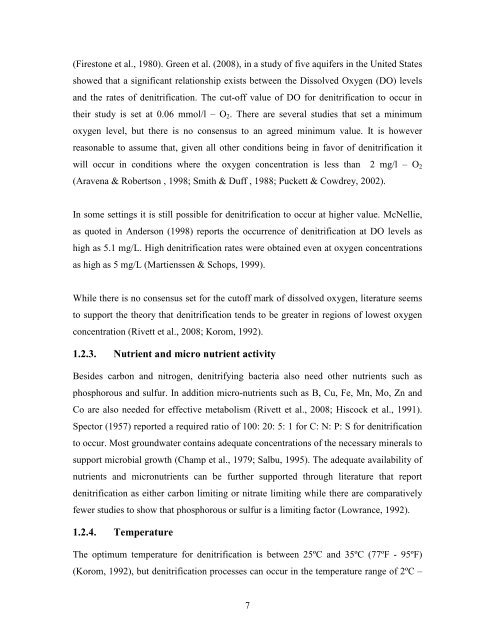THE FLORIDA STATE UNIVERSITY ARTS AND SCIENCES ...
THE FLORIDA STATE UNIVERSITY ARTS AND SCIENCES ...
THE FLORIDA STATE UNIVERSITY ARTS AND SCIENCES ...
You also want an ePaper? Increase the reach of your titles
YUMPU automatically turns print PDFs into web optimized ePapers that Google loves.
(Firestone et al., 1980). Green et al. (2008), in a study of five aquifers in the United States<br />
showed that a significant relationship exists between the Dissolved Oxygen (DO) levels<br />
and the rates of denitrification. The cut-off value of DO for denitrification to occur in<br />
their study is set at 0.06 mmol/l – O2. There are several studies that set a minimum<br />
oxygen level, but there is no consensus to an agreed minimum value. It is however<br />
reasonable to assume that, given all other conditions being in favor of denitrification it<br />
will occur in conditions where the oxygen concentration is less than 2 mg/l – O2<br />
(Aravena & Robertson , 1998; Smith & Duff , 1988; Puckett & Cowdrey, 2002).<br />
In some settings it is still possible for denitrification to occur at higher value. McNellie,<br />
as quoted in Anderson (1998) reports the occurrence of denitrification at DO levels as<br />
high as 5.1 mg/L. High denitrification rates were obtained even at oxygen concentrations<br />
as high as 5 mg/L (Martienssen & Schops, 1999).<br />
While there is no consensus set for the cutoff mark of dissolved oxygen, literature seems<br />
to support the theory that denitrification tends to be greater in regions of lowest oxygen<br />
concentration (Rivett et al., 2008; Korom, 1992).<br />
1.2.3. Nutrient and micro nutrient activity<br />
Besides carbon and nitrogen, denitrifying bacteria also need other nutrients such as<br />
phosphorous and sulfur. In addition micro-nutrients such as B, Cu, Fe, Mn, Mo, Zn and<br />
Co are also needed for effective metabolism (Rivett et al., 2008; Hiscock et al., 1991).<br />
Spector (1957) reported a required ratio of 100: 20: 5: 1 for C: N: P: S for denitrification<br />
to occur. Most groundwater contains adequate concentrations of the necessary minerals to<br />
support microbial growth (Champ et al., 1979; Salbu, 1995). The adequate availability of<br />
nutrients and micronutrients can be further supported through literature that report<br />
denitrification as either carbon limiting or nitrate limiting while there are comparatively<br />
fewer studies to show that phosphorous or sulfur is a limiting factor (Lowrance, 1992).<br />
1.2.4. Temperature<br />
The optimum temperature for denitrification is between 25ºC and 35ºC (77ºF - 95ºF)<br />
(Korom, 1992), but denitrification processes can occur in the temperature range of 2ºC –<br />
7
















